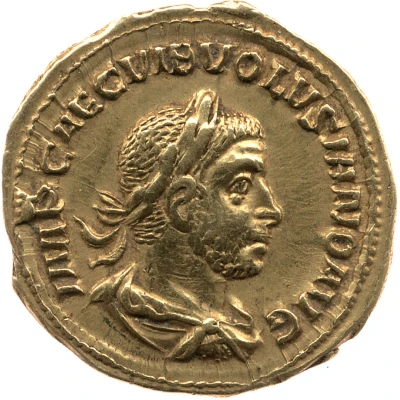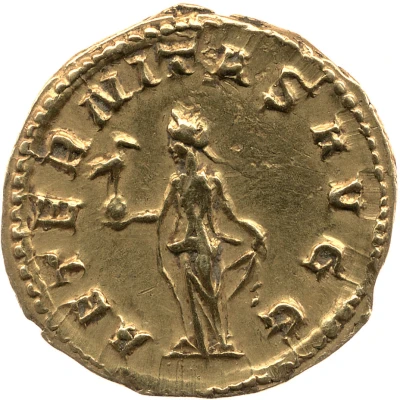


© Trustees of the British Museum
Aureus - Volusianus AETERNITAS AVGG; Aeternitas
| Gold | 3.9 g | 20 mm |
| Issuer | Rome › Roman Empire (27 BC - 395 AD) |
|---|---|
| Emperor | Volusianus (Gaius Vibius Volusianus) (251-253) Trebonianus Gallus (Gaius Vibius Afinius Trebonianus Gallus) (251-253) |
| Type | Standard circulation coin |
| Years | 251-253 |
| Value | Aureus (25⁄2) |
| Currency | Antoninianus, Reform of Caracalla (AD 215 – 301) |
| Composition | Gold |
| Weight | 3.9 g |
| Diameter | 20 mm |
| Shape | Round (irregular) |
| Technique | Hammered |
| Demonetized | Yes |
| Updated | 2024-10-05 |
| Numista | N#284025 |
|---|---|
| Rarity index | 100% |
Reverse
Aeternitas, draped, standing left, holding phoenix on globe in right hand and raising skirt at side with left hand.
Script: Latin
Lettering: AETERNITAS AVGG
Translation:
Aeternitas Duorum Augustorum.
Eternity of the two emperors (Augusti).
Comment
Mass varies: 3.75–4.08 g;Example of this type:
Trustees of the British Museum
Source:
Online Coins of the Roman Empire (OCRE)
Interesting fact
One interesting fact about the Aureus - Volusianus coin is that it features the image of Aeternitas, the Roman goddess of eternity, on its reverse side. This is significant because Aeternitas was a relatively new deity in the Roman pantheon at the time, and her inclusion on the coinage suggests that the Roman Empire was beginning to emphasize the idea of eternity and the perpetuity of the imperial system. Additionally, the use of gold for the coin's material was a symbol of the empire's wealth and power.